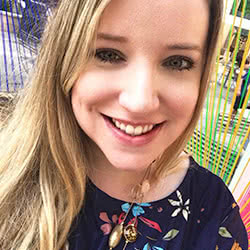Finding belonging, discovering Baltimore
Meet the Loyola student who has visited every neighborhood in Charm City—on foot
 Claire Hoffman, ’07
Claire Hoffman, ’07
“You can’t be a good citizen—and therefore a good person—if you don’t know your community,” proclaims Andrew Boyadjian, ’19.
And Andrew would probably know a thing or two about the community.
And he did it all without the use of cars, occasionally using mass transit, but mostly relying on his own two feet.
“I’m a huge fan of just walking and exploring new parts of the city,” Andrew explains, noting that he knew next to nothing about Baltimore when he applied to Loyola from his hometown in Ho-Ho-Kus, New Jersey.
“When I got here, I very quickly fell in love with just how intimate and grand and charming everything is. ‘Charm City’ is really the perfect nickname for Baltimore.”
Andrew never intended to walk to every neighborhood. In October of his first year, he simply decided to explore a bit off-campus, which led to walking a few miles every week… which then led to a few six- to 12-mile walks per month.
Then last fall, he walked a whopping 34 miles in one day. (He confirms he has gone through several pairs of sneakers.)

For Andrew, walking has been a way to find his place at a new university in an unfamiliar city.
“I was curious to see if I felt like I belonged at Loyola, if I belonged in Baltimore… The more I walked, and the more I found places that even Baltimore natives hadn’t heard of, the more I really felt like I belonged here.”
Eventually, he decided to consult a map and see how many areas he had been to. When he realized in February that he’d visited 215 of Baltimore’s 279 neighborhoods, Andrew was determined to explore them all.
“I spent the next month doing seven-mile walks every Monday, Wednesday, Friday, and Saturday. I visited my last neighborhood, Four by Four, [on April 13].”

Andrew plans to spend the rest of the semester revisiting his favorite areas, including the Johnson Square, Oliver, Broadway East, Berea, and McElderry Park neighborhoods. “Those spots are incredibly quiet and peaceful. You can stand in the middle of the road and see for miles; it’s very cool.”
That’s not to say Andrew avoids interacting with the people he encounters.
“My favorite question to ask is, ‘How do you like the neighborhood you live in?’” he says, recalling a time a young boy invited him to join a game of basketball.
Mostly, though, he enjoys the mundanity of walking and uses the time to observe the subtle nuances between neighborhoods and catch up on podcasts. His entertainment of choice also reflects his love for his adopted city: Andrew likes listening to Baltimore magazine’s “Buzzed in Baltimore” podcast about local breweries, plus Baltimore-based musicians Future Islands, Snail Mail, JPEGMAFIA, and Dan Deacon.
Andrew's love for and knowledge of the city made him an ideal choice to lead Loyola’s Experience Baltimore, a Pre-Fall Program to introduce incoming students to the city before they begin their first semester of college.
I think everyone should be putting in the effort to see what’s out there, to form their own opinions about the city.
It’s a position he’s held for the past three years, and his goal has been to expose incoming students to areas beyond the Inner Harbor and other well-known spots in the city.
“We do service on York Road as part of the York Road Initiative, we go to Belvedere Square to eat local food, we do ice breakers in Patterson Park, stuff like that,” he explains. “It gets them acquainted with different parts of Baltimore—so, the hope is they will then go to those areas on their own and really see what the city has to offer.”
Andrew thinks it’s crucial for Loyola students to understand and appreciate the city they call home for four years.
“Loyola as an institution is so well-connected with the city through service, through job opportunities,” he said. “But I’ve noticed that students are hesitant to explore on their own. I think everyone should be putting in the effort to see what’s out there, to form their own opinions about the city.”
One thing that has struck Andrew during his walks is the city’s income and race disparities from street to street—though he makes a point to avoid words like “bad neighborhood,” preferring to use terms like “neglected.”
“Language is important because it affects people’s perspectives,” he noted, saying that also avoids saying he’s “touring” a neighborhood.
I don’t go on tours of West Baltimore; I live in Baltimore, and so I go on ‘walks’ or ‘adventures’ or ‘explorations’ of West Baltimore.
“It makes it sound like I am a visitor, and it can be insulting that neglected areas are just there to be toured and then ignored,” he explains.
“I don’t go on tours of West Baltimore; I live in Baltimore, and so I go on ‘walks’ or ‘adventures’ or ‘explorations’ of West Baltimore. I think it’s important for all of us to understand that divide, so we can put effort into breaking down the barriers.”
For his part, Andrew says he never felt unsafe on his walks—though he recognizes the privilege that comes with his race and gender. “You can’t gauge the feel of a city based on what you read about it, on the stats,” he said. “You have to really walk around and talk to people. If Baltimore is the most dangerous city in America, then that makes me feel pretty good for America.”
While he is still figuring out his post-graduation plans, Andrew says he hopes to eventually end up in Baltimore. “My ultimate goal is to walk every street in the city,” he said. “I don’t know how many there are—but I can’t be that far off.”